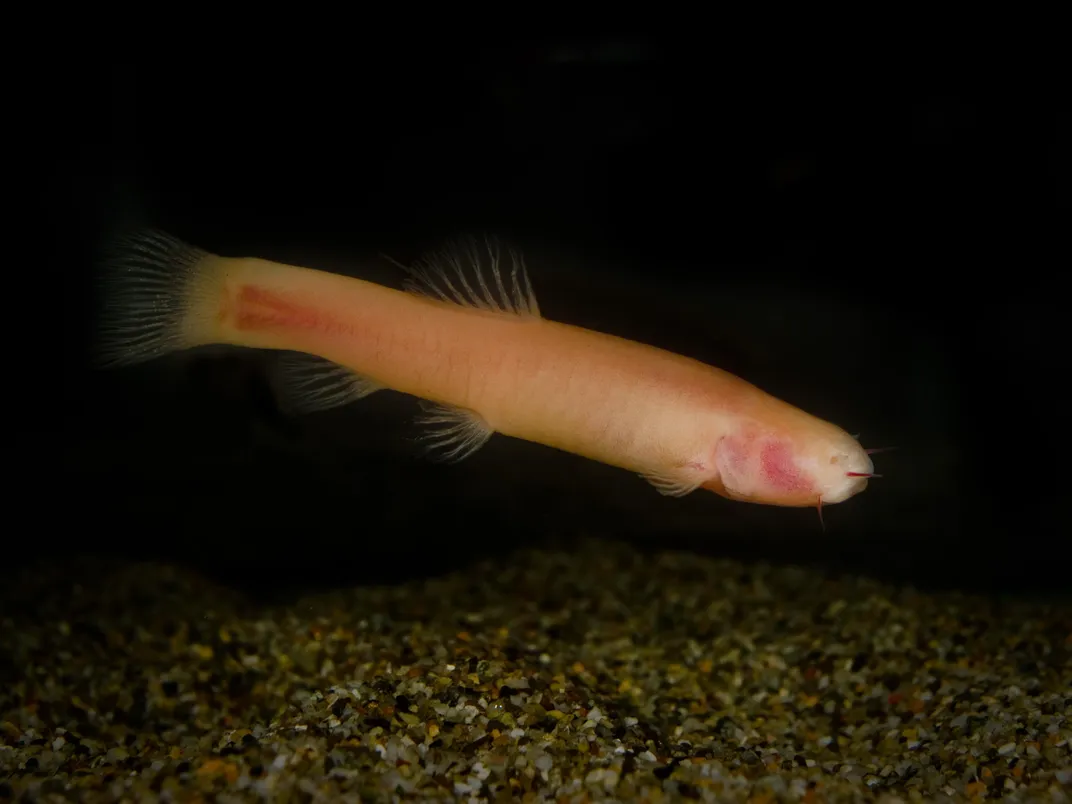Blind Cavefish Shed Light on the Dark Days of Mammalian Evolution
Like mammals, these cave-dwelling creatures have discarded a solar-powered system that repairs UV-damaged DNA
/https://tf-cmsv2-smithsonianmag-media.s3.amazonaws.com/filer/c9/31/c93161df-0def-48d0-abad-6178e8c1894e/cyprinidae_-_phreatichthys_andruzzii.jpg)
Pale, shrunken and blind, the Somalian cavefish lives a quiet life in the world’s most light-starved waters. With their ghastly pallor and no eyes to speak of, these pasty fish don’t seem to have much in common with mammals, but there’s far more to the humble cavefish than meets the eye.
Scientists reported yesterday in the journal Current Biology that cavefish could shed some much-needed light on a mysterious chapter of mammalian evolution: the loss of solar-powered DNA repair. Most organisms have mechanisms to repair their own DNA molecules activated by sunlight, but mammals lost the trait somewhere along the way—and so did the Somalian cavefish.
As the instruction manual for life, DNA is a precious commodity. Sustained damage to this vital code contributes to both aging and increased susceptibility to cancer. Unfortunately, the process of copying and reading DNA can be riddled with errors, and the environment around us is fraught with perils, ranging from harmful chemicals to rays of ultraviolet light capable of altering genetic sequences.
But thanks to a suite of cellular machines capable of repairing compromised DNA, most of these genetic mishaps are rectified without consequence. Among these crucial repair capabilities is the photoreactivation system, which uses a solar-powered enzyme called photolyase to fix errors in DNA caused by exposure to UV radiation. This clever defense mechanism means that the same hazard that damages DNA—sunlight—also triggers a repair system for the genetic code.

While photoreactivation is widespread across the tree of life, it’s completely absent in mammals. And for a long time, we thought we were alone. But scientists began to discover a handful of fungal and nematode species (and some select populations of cave-bound crustaceans) that had also lost their solar-powered DNA repair capabilities. The newest addition to the dark-dwelling group, Somalian cavefish, might be the first non-mammalian vertebrates to have undergone a similar step of evolutionary history.
“[Photoreactivation] is a system that’s so conserved, from bacteria all the way to plants and many animals,” says Nicholas Foulkes, a biologist at the Karlsruhe Institute of Technology in Germany. “When you see loss of the function, it’s profound.”
So how might a cavefish resemble a mammal? The answer, it turns out, keeps us literally in the dark. Our mammalian ancestors enjoyed a highly nocturnal lifestyle, says evolutionary biologist Roi Maor of University College London. Hundreds of millions of years ago, our warm-blooded animal forebearers may have hid during the daytime to avoid being eaten by sun-loving dinosaurs.
This nocturnal nature may have activated a “use it or lose it” principle in our evolution. Sunnier traits (like solar-powered photoreactivation) could have been discarded due to about 100 million years of disuse, Maor says. These genetic losses then persisted into modern times, even after mammals began to venture back into the daylight.
Foulkes’ research group, including lead author on the new study Haiyu Zhao, set out to study DNA repair in other nocturnal animals to learn more about the loss of photoreactivation mechanisms. The Somalian cavefish (Phreatichthys andruzzii), with its aversion to sunlight, was a perfect creature to examine.
First, though, the researchers needed a point of comparison. For this, they chose another freshwater fish as a foil: the zebrafish, a well-studied staple in many biological labs. Like most other animals, zebrafish genomes encode the sunlight-enabled photoreactivation system, allowing them to survive exposure to high doses of UV radiation in well-lit environments. But UV-zapped zebrafish trapped in total darkness are more sensitive to the repercussions of DNA damage.
On the other hand, when the researchers conducted these same experiments on Somalian cavefish, the fish were hypersensitive to UV rays. In the wild, the species lives in complete isolation from sunlight, and exposing the fish to conditions that mimicked sunlight didn’t help them survive the UV radiation.

By delving into the fishes’ genomes, the researchers found that zebrafish manufacture three restorative photolyases that power up in the presence of sunlight, while Somalian cavefish encode only a broken system. Upon further examination, the researchers were able to determine differences in how zebrafish and cavefish controlled photolyase expression.
In the presence of light, a molecular “key” in zebrafish cells is guided to a genetic “lock,” which is released to activate DNA repair mechanisms. The cavefish, oddly enough, seemed to have intact locks, ready to unleash photolyase expression—but the keys appear to have been lost to time. Foulkes’ team is currently searching for damaged or missing keys in the cavefish genome.
“It’s like evolution is caught in the act,” Foulkes says. “You can see the process by which the repair system is being lost.”
Over 200 species of cavefish populate the Earth, but this Somalian specimen is the first reported to have lost the photoreactivation system. Even among cavefish, however, P. andruzzii is an extremist, having spent the past 3 million or so years out of the sun. In the eternal darkness of underwater caverns, it’s in this swimmer’s best interests to conserve energy for the long road ahead—according to Foulkes, these fish can live upwards of fifty years—which means getting rid of any unnecessary genetic baggage.
While mammals don’t share the lifestyles of cavefish, these genetic losses may reveal the murky evolutionary trajectories that divergent species share. Rather than developing a useful trait under environmental pressure, the creatures seem to have abandoned a system that was no longer useful, says Silvia Fuselli, a cavefish expert at the University of Ferrara in Italy.
“Maybe these fish are reproducing something that happened in our ancestors millions of years ago,” Foulkes says.
Given that some sun-shirking species are probably still successfully eluding human discovery in Earth’s cavernous caves and deep-sea trenches, we probably haven’t found the last of creatures that have shed photoreactivation. “It’s showing up in these fish, in fungi, in [crustaceans]… it’s going to be something that people find consistently,” says David Carlini, a biologist at American University who studies cave-dwelling freshwater crustaceans.
And as far as we know, P. andruzzii is still pretty unique among most of its light-loathing brethren. Until more species that prefer the dark can be studied, the Somalian cavefish may be the guiding light to solve the mystery of how us mammals lost our ability to heal in the sun.
/https://tf-cmsv2-smithsonianmag-media.s3.amazonaws.com/accounts/headshot/10172852_10152012979290896_320129237_n.jpg)
/https://tf-cmsv2-smithsonianmag-media.s3.amazonaws.com/accounts/headshot/10172852_10152012979290896_320129237_n.jpg)